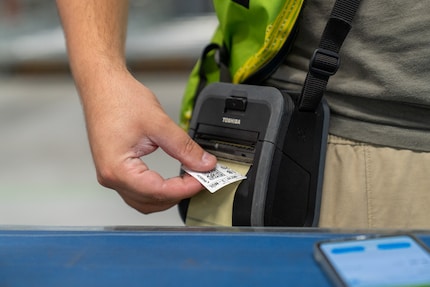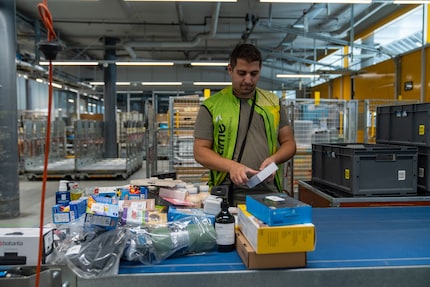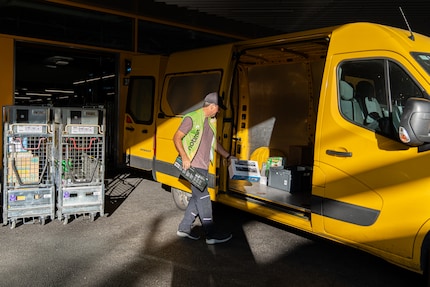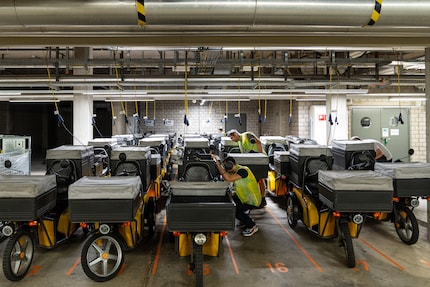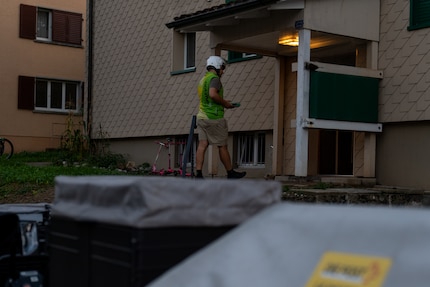
Behind the scenes
Matcha’s booming: one in eight teas is green powder
by Alex Hämmerli

Starting mid-November, 60 per cent of households in Switzerland will be able to enjoy flash delivery. But what exactly needs to happen in order for the hut sleeping bag I’ve ordered to be delivered the same day? The answer involves a sophisticated logistical operation, run in tandem with selected partner companies.
I quickly find the right sleeping bag, add it to my shopping cart, select the flash delivery option at the checkout and pay. All that’s left to do is wait.
But how does this seemingly impossible logistical process actually work? Time to take a closer look.
«Same-day delivery orders are handled the same way in our system as orders for collection in one of our 10 stores. They’re prioritised to ensure timely shipping,» says Thomas Amhof, the man at Digitec Galaxus responsible for the final stretch of a parcel’s journey.
Once my small, silk sleeping bag has been located, it’s packed into a grey crate before travelling straight to the outgoing goods area via conveyor belt. There, an employee takes the crate and loads it onto an RX trolley provided by our forwarder, Post. Once they’ve been loaded up, the trolleys go into delivery trucks.
Larger products don’t need to go into crates. Instead, they’re loaded straight onto an RX. Once the trolleys are full, they’re kept in a waiting room temporarily. Delivery drivers collect the trolleys from there before loading them into their trucks, ready and waiting at the outgoing goods area ramp. The vehicle doors are then sealed shut and the truck leaves the warehouse.
Every morning, dozens of trucks leave our main warehouse in Wohlen. Three of them are entirely dedicated to forwarding flash deliveries to our partner notime. The first truck leaves the site at 9 a.m., with the final one departing no later than 12.30 p.m. Last Mile Manager Thomas says this last trip is both the riskiest and most important.
«The only part of the process we handle is the picking. If our customers order several products at once, we don’t put them together,» says Thomas. Order consolidation (the process of bringing multiple products together) takes place later in the day at notime, a lightning quick, last-mile delivery service.
The truck arrives in Buchs at 1 p.m., moving on to other hubs at 2 p.m. That gives the employees one hour to unload the RX trolleys, scan all the products, stick a QR code on them, pack them back onto the trolleys and push them into the next truck. On a typical day, there are 1,500-2,000 flash deliveries, each order comprising of about two products. And the numbers are rising.
One of these hubs is located in Mülligen near the city of Zurich. The mail centre is enormous – a hive of activity. When I go to check it out, there are piles of political election flyers lying on RX trolleys all over the place. Letters are transported from A to B by conveyor belts. The centre is in operation 24/7, with even the cafeteria open around the clock. In between lifting bundles of letters, employees can even lift weights in a small gym.
In one corner, three employees set up a small conveyor belt and process the unpackaged products that the truck has just delivered. At the same time, notime’s system assigns each order to a particular delivery run.
An employee places the scanned products into different crates. Each crate corresponds to a different delivery run. Mülligen serves an area spanning from the city of Zurich to the Zurich/Aargau cantonal border. Parcels destined for addresses further away are transported to microhubs in Thalwil and Wädenswil for dispersion.
One floor below, dozens of yellow Kyburz electric scooters (DXP) are charging.
Each courier is responsible for loading their own vehicle. They each have their own system for finding the right product as quickly as possible when they arrive at the delivery address.
Once the scooter and trailers have been loaded up, the environmentally friendly electric vehicles go swarming out onto the streets. The DXPs usually hit the road between 6 and 6.30 p.m.
The battery charge holds out for 40-50 kilometres – enough to deliver every single product before the 10 p.m. deadline. However, things don’t always go quite so successfully. «Deliveries can be unpredictable from time to time, mostly due to external factors,» says Kagan Hibbert, the manager of Müllingen’s notime hub.
The couriers currently deliver 96-97 per cent of all orders to customers on time. Eight hours after I place my order, notime’s flash delivery courier rings my doorbell. There’s nothing left standing in the way of my mountain hike in the beautiful canton of Valais.
What do you think of flash delivery? Is it the logistical masterstroke we’ve all been waiting for? Or is it just another service we don’t really need?
As a Multimedia Producer, preparing multimedia content and knowing about cutting-edge technology is my business. My main focus at digitec is producing videos. I can’t wait to try out new products such as cameras, drones or smartphones as soon as they’re launched. This is where being at the source comes in rather handy. When I’m not working, I’m probably skiing, biking or hiking – the mountains are my place to be.
News about features in our shop, information from marketing and logistics, and much more.
Show allI’ve had the date circled in my calendar for a while now: a hiking trip to Weissmies mountain, complete with an overnight stay at the Swiss Alpine Club’s (SAC) «Almagellerhütte» hikers’ hut. The day before I leave for the canton of Valais, I stuff my backpack with warm clothes, a headlamp, crampons and other gear. I should also be taking a hut sleeping bag, the use of which is mandatory in most SAC huts. Annoyingly, I tore mine the last time I used it and I’m in dire need of a new one. The sports shop is located in a city-centre area chock-a-block with cars, and my diary for the day is already full. The only place left for me to turn to is the Galaxus app on my smartphone.
My hurriedly purchased hut sleeping bag is currently sitting in Wohlen, Aargau. Hundreds of employees scurry through the aisles of the warehouse, a place with a surface area so gigantic that it could fit into the concourse of Zurich’s main station almost 11 times over. My sleeping bag is in the mini warehouse, where medium-sized products are stored. Richard, an amateur DJ and warehouse employee, picks the product manually from one of the countless racks. A small device lets him know what to pick and where to find the product.

The ultimate goal is to have the delivery trucks depart from the Digitec Galaxus warehouse on time. This is the only way for notime to be able to sort all the products in time. If a truck leaves too late, it’s impossible to make up for lost time. It takes abound 30 minutes to transport the goods to the parcel centre in Buchs, Aargau. There are hundreds of flash deliveries on the loading bridge, my sleeping bag lying somewhere in amongst them. At the parcel centre, notime scans the products’ EAN codes (the barcode found on every product), sticks a QR code on them and ships them off to eight distribution centres throughout Switzerland, known in the trade as «hubs».
